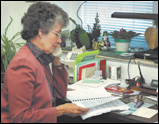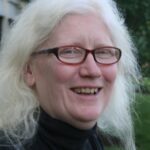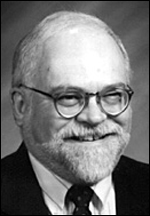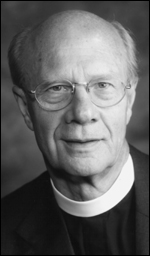 |
| Sister Elizabeth Willems was extremely frustrated.
Photograph by Frank Methe |
“I was extremely frustrated,” said Sister Elizabeth Willems in a tone which makes it clear that she does not tolerate such a state of affairs for long. “I thought, ‘this is my ministry and I’m not doing it well.’” The ministry to which she refers is that of teaching at Notre Dame Seminary in New Orleans, Louisiana. It’s not a new calling for Willems; she has been at the school since 1985. But a few years ago the mix of students became such that, she said, “I couldn’t teach to the middle and both ends at the same time.” She had students with widely divergent academic backgrounds, life experience, academic ability, and facility with the English language, and she needed help in figuring out how to teach them all at the graduate level.
Andrew Dearman was, at about the same time, trying to head off a frustration he saw looming on the horizon. Newly installed as dean of Austin Presbyterian Theological Seminary, he realized that although he, like his predecessors, had come to the office through the ranks of faculty, he was different from them in that he wanted the dean’s job to look more like it was set forth in his job description and less like it had when the school was smaller and the dean’s office served as a hub for students as well as faculty. He needed help to see to it that student needs—academic, vocational, and practical—were being met without overstraining him or the faculty.
Different schools, different people, different students, different challenges—but Willems and Dearman both found the help they were looking for. They signed on with programs that gave faculties time and encouragement to think about their work of teaching and how it fits into the whole mission of their schools.
 |
| Austin Presbyterian Theological Seminary’s faculty team as it prepared for the Lexington Seminar. |
Keystone and Lexington
“Theological Teaching for the Church’s Ministries,” known to everyone involved as the Keystone Project (for the seminars’ location at the Keystone resort near Dillon, Colorado), was designed for Roman Catholic schools. A second program of the same name, popularly known as the Lexington Seminars (It’s administered from Lexington Theological Seminary in Kentucky, but held on the Maine coast), is for schools of other denominations and none. The programs are separate but interrelated. They are similar in structure, and both have been funded by large grants from the Lilly Endowment ($3.2 million for Lexington, $1.3 million for Keystone, which also received $420,000 from the Mae Bonfils Stanton Trust of the Holy Name Province of the Order of Friars Minor). Twenty schools have been part of each program to date; Lexington has plans for seminars for fifteen more schools.
The pattern for the summer gatherings is similar. Each participating faculty is asked to develop a case study, which is then presented by a small group at a seminar at which four other schools are also presenting. Groups have facilitators; plenary sessions feature experts in education, in formation, in trends in theological education. They take their projects home to refine and implement, and then gather again for more input. The schools involved are diverse, but their projects tend to form around similar issues—Keystone has divided them into four categories: coping with learning differences (having to do with cultural factors), theological differences, integrating academics with the formation of ministers, and assessing a school’s performance. The similarity of challenges surprised participants repeatedly, underscoring the need for programs that bring together people with a shared involvement in theological education.
“I went to the dean for help,” said Willems of her frustration, “but he didn’t know what to do, either. So I went to Tulane (just a short ride on the St. Charles streetcar from Notre Dame) because I’d heard some people there were doing interesting work with adult learners, but they’d left!” Willems was prepared to go on searching, but by then the Reverend Jose Lavastida, Notre Dame’s dean, had heard of the Keystone Conferences, and the school signed on.
The first task was getting the faculty united, willing to work on the same project. Everyone agreed that student diversity was the big issue. “We have students from twenty-four U.S. dioceses (granted, all in the Southeast) and one in Uganda, six religious communities (two of which are Vietnamese), as well as lay students. Their ages range from twenty-one into their sixties. The majority are second-career, and they have widely diverse life experience—a couple even have grandkids. They come from fifteen countries and a full range of spiritualities,” said the Reverend Patrick Williams, the school’s president and rector, in a first attempt at explaining his array of students. Other differences are mentioned in the course of conversation; issues of social class, commuter vs. resident student, and motivation. Some faculty wanted a focus on theoretical considerations of and theological reflection on diversity, but as Willems acknowledges with robust good cheer, “I was pushy on this point. I needed input on how to teach.”
Diversity Seminars
The faculty named its project TEAM (Theological Education and Ministry: a faculty development project) and set about scheduling monthly faculty seminars on diversity. Some involved presentations by outside speakers—on a mix of theoretical and practical topics. Other seminars involved searching out common ground: the faculty expressed its commitment to accepting diversity, to changing some approaches to teaching, to helping students change some of their approaches to learning. Somewhere along the way the word “diversity” gave way to “differences,” a word with less political baggage and more breadth. A three-year strategic plan—scheduled to begin this fall—was developed around the areas of teaching methods, student life, and curriculum review.
And in the meantime, teaching styles have begun to change.
 |
| Patrick Williams, Notre Dame’s president/rector, chats with dean Jose Lavastida.
Photograph by Frank Methe |
Willems, for example, is trying to learn more about how her students learn. She gives them a learning-styles inventory on the first day of class, and explains what students can do with knowledge of their styles. And she doesn’t assume that she has a clear understanding of what her students’ capabilities are. “I test in students’ first languages now if they request it, using a more fluent student to translate. I tried that after a student I thought was quite fluent flunked a test—and when he retook it in his own language, he got a B. He was so grateful he gave me a little statue of Our Lady of Guadalupe. I wouldn’t have done that once upon a time, I would have focused more on English. Now I think it’s more important to teach the material than the language. I also arrange study groups by student choice, and if people who share a first language want to work together, that’s fine.” She also supplies a written outline of her classes to students who want it, so notetaking can be more a matter of filling in interesting detail than struggling to catch the basics, although she notes that for some learners, the writing is an important part of the learning.
Immediate Feedback
Lavastida cites a presentation on “classroom research” as a helpful one for him. “I’m more interested now in making sure that they’ve got it, that they’re with me.” He sometimes reserves the last five minutes of class so that the students can write about the muddiest part of the lesson just completed. It’s immediate feedback for the teacher. Williams, the school’s rector, has been focusing on drawing student experience as a source of their understanding. He begins his introduction to pastoral theology by asking students to define ministry according to ministry they’ve done. “Affirm that they have something to share—even the hyper-critical ones,” he said. Some students are more appreciative of this approach than others: some class evaluations express gratitude for the student input, others say, “I wish we didn’t have to listen to other students.” Williams says that students with richer life experience tend to be more appreciative of other students’ input.
In an attempt to keep the attention of the brightest students and give them an opportunity to be supported as they learn more, each core class at Notre Dame has an advanced theology seminar—a small group centered on additional readings—built in. Not many students take advantage of the opportunity, but Lavastida finds them a good way for students to dig into topics there’s no time to cover in class, and since the material is prepared already, there’s no undue strain on the teacher (unlike independent study, which Willems said can be as demanding for the teacher as creating a new course). Lavastida appreciates the way sometimes the small groups’ efforts are carried back into the larger class, as students make presentations on topics of special interest; it’s a chance for students to work on their teaching skills. Lavastida notes that no more than ten percent of students participate in the seminars: Willems points out that, “some able students want to live normally.” She notes that some of her seminars turn into more advanced discussion of class material, attended by the more highly motivated, not just truly advanced students.
Would Willems have found a way to improve her teaching without the Keystone conferences? Certainly. But for her, the point was knowing that she wasn’t doing it alone. Willems is a member of the School Sisters of Notre Dame, a religious community centered on teaching, but most women in the order teach on the high school or college level. Willems can think of only two others teaching seminary, and she admits to having felt a little isolated at her school. She says a major benefit of Keystone was discovering that other people love their work as much as she does, and that the decisions they make about how to teach come out of their unique contexts. And it’s not just her peers at other schools she’s grown closer to—the fact that Notre Dame’s faculty was committed to doing the project as a team has given her a new appreciation of her own faculty.
In the Land of Texas
Like Notre Dame, Austin Presbyterian Theological Seminary has been growing slowly but steadily over the last couple of decades, and like Notre Dame, the size has necessitated some adjustments in the way students are shepherded. Once upon a time, student life was under the aegis of the faculty’s “student standing” committee. That was when the school was almost entirely Presbyterian and almost entirely residential. Things have changed, and Professor of Christian Education Laura Lewis, who got her M.Div. from Austin in 1978, knows how. “Back then, we were fifteen or twenty percent women, and had almost no ethnic diversity. We were almost all Presbyterian, excepting a Baptist or two, a few people from the Church of Christ, and a beleaguered little group of Methodists. Nobody had jobs—there was a biblical competency exam the Presbyterians had to take, so everyone else did, too, and that was pretty much all-consuming. There were almost no commuters.” Now the student body is less male, less Anglo, less Presbyterian. While the school is still largely residential, commuters and part-time students abound—including some who started studies at the school’s extension program in Houston. “We offer a class or two per semester there,” explained Lewis, “and some students with a lot of credits wanted us to offer a full program. We decided that after they have half their courses done there, they can come here and finish. Some move, some commute by the week.” Individual classes have their own quirks, of course. One recent year saw three dozen teenagers living on campus. “We were offering financial aid to anyone who would play games with them,” said Lewis.
| Who’s Who
At Notre Dame Patrick Williams At Austin Robert Shelton |
Her use of the word “we” in that sentence gives a clue about how involved faculty have been in student lives. Faculty were working with varying degrees of success to balance that involvement with their teaching, their own academic projects, and their involvement with church life. Ismael Garcia, for example, fielded four phone calls during a recent half hour meeting in his office, some from students, some in reference to the Hispanic Theological Institute and its upcoming summer program, with which he is deeply involved. He is quick to point out that although it is not a school with a “publish-or-perish” ethos, the rest of the faculty is similarly involved with projects of their own. Faculty members’ involvement in congregational life extends beyond their own congregations, and as Dearman describes it, “It isn’t nurtured, it just happens.” That seems to be true in part because Austin is still largely a regional school and because an exceptionally high percentage of its graduates are in pastoral ministry.
Faculty Overextensions
Dean Dearman found himself in the center of this faculty overextension. “People wrongly assume that by virtue of holding this office you have power and influence,” he said, explaining the sheer number of people who wanted a piece of his time. His response was partly a matter of asserting his own leadership style: while previous dean (and current president) Robert Shelton is nobody’s codependent—he says the best advice he ever received on deanship was, “You can always qualify a no: you can never qualify a yes”—he was more inclined to want to be part of every conversation than is Dearman.
The dean’s office was inescapably the center of several projects that happened at the same time: the development of a long-term “master plan” for the school, an ATS reaccreditation visit, and the Lexington Seminars. The common theme had to do with reflection on the school’s culture, on core issues of identity. And the sense of the faculty, administration, and trustees after a two-and-a-half day retreat in the Texas hill country west of Austin last spring—a retreat including high-powered consultants and time to play golf—was that the school was doing what it wanted to do—preparing people for ministry in a (mostly) residential community-and doing it pretty well. There also came a realization that perhaps the style of interaction with students was lacking boundaries, that structures could be put into place to make student services flow more effectively. A task force was put in place, and soon a new position was created—vice president for student affairs. Ann Fields, an Austin graduate with a background in counseling and spiritual direction, was hired. She says with utter sincerity of her post, “It’s the best job in the world.” She realizes that it will take time for students to see her office as a natural first stopping place, but since admissions is one of the areas under her aegis, she meets students even before they come to the school. She also has oversight over financial aid, student services, and placement services.
Special Enthusiasm
The faculty review of the curriculum was “not earthshaking,” to quote Garcia—the major changes recommended have to do with the teaching of biblical languages and a call to be mindful of diversity in the planning of individual classes—but there was one element of the review about which faculty are especially enthusiastic. Each faculty member brought syllabi from two courses, a core course and an elective, for their peers to spend some time with. “We get each other’s syllabi, of course, but we never look at them,” said Lewis. “It was so cool to hear everybody’s stuff and how much they love it.”
And that, perhaps, is the center of the Keystone and Lexington experience, for faculty to recall their love for both their subjects and their students, to focus on teaching and how it has changed along with everything else. Sometimes it takes a week in the fresh air to return to the obvious, sometimes energy and attention needs to be bought and nurtured. And when people are given time to pay attention to important things, they can help their worlds to make graceful changes.



























